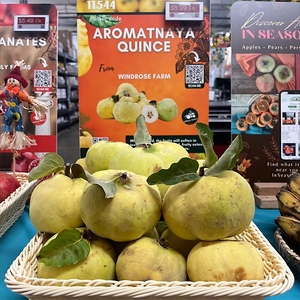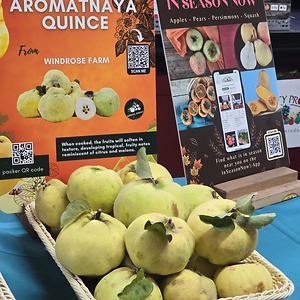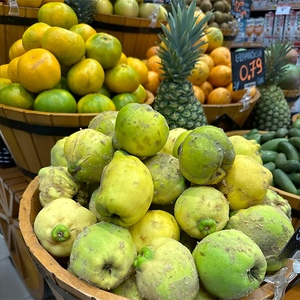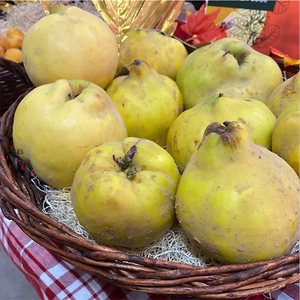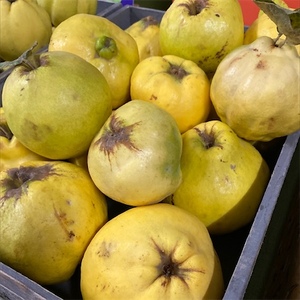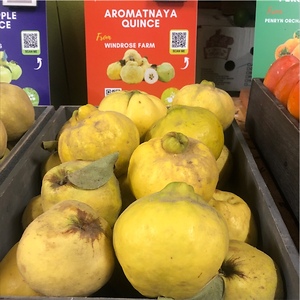

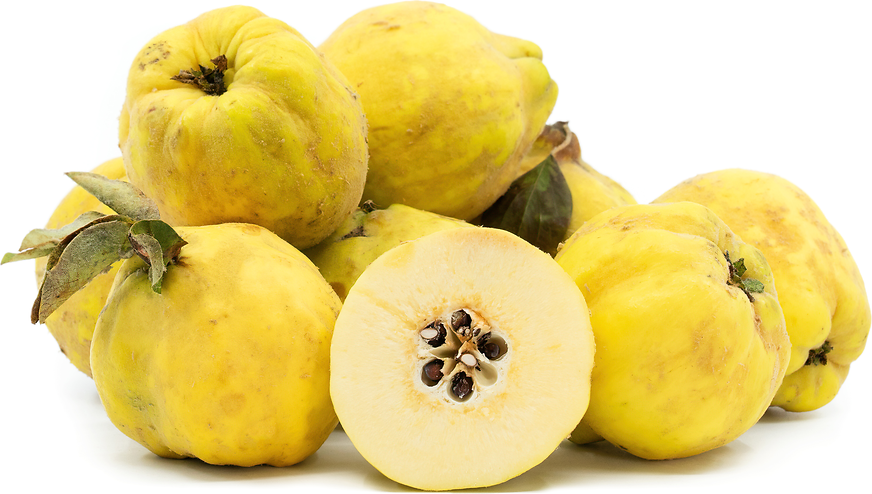
Aromatnaya Quince
Estimated Inventory, lb : 0
This item was last sold on : 10/02/24
Description/Taste
Aromatnaya quinces are medium to large fruits, averaging 7 to 10 centimeters in diameter, and have a round to ovate shape with a small and curved, raised neck. The skin is firm, smooth, thin, and delicate, easily bruised, and has a bumpy texture with an oily consistency, ripening from green to a golden, lemon yellow when mature. It is important to note that the skin will remain firm when ripe and will develop a musky, tropical, and floral scent. Underneath the surface, the flesh is white, dense, and semi-aqueous, encasing a central core filled with dark brown seeds. Aromatnaya quinces have a sweet-tart, mildly astringent flavor when raw and can be eaten fresh. When cooked, the fruits will soften in texture, developing tropical, fruity notes reminiscent of citrus and melons.
Seasons/Availability
Aromatnaya quinces are available in the fall through winter.
Current Facts
Aromatnaya quinces, botanically classified as Cydonia oblonga, are a Russian variety belonging to the Rosaceae family. The large fruits grow on deciduous trees and are a rare cultivar that is favored as one of the few quince varieties that can be eaten fresh when ripe. The name Aromatnaya roughly translates from Russian to mean “fragrant” or “aromatic” and is a home garden variety grown by quince enthusiasts in Eastern Europe and the United States. Despite their limited availability, Aromatnaya quince trees are disease resistant, highly prolific, and somewhat adaptable, producing aromatic fruits that can be utilized in a wide variety of culinary applications.
Nutritional Value
Aromatnaya quinces are a good source of vitamin C, which is an antioxidant that can strengthen the immune system, reduce inflammation, and boost collagen production within the skin. The fruits also provide copper to increase metabolism and contain fiber, potassium, iron, vitamin A, and magnesium.
Applications
Aromatnaya quinces are best suited for cooked applications, including stewing, poaching, baking, or simmering. The aromatic fruits are one of the few quince varieties that can be eaten raw when ripe, but it is recommended to thinly slice the fruit into pieces to minimize any tart or astringent flavors. The thin slices of the quince can be a crisp addition to salads, grated into fruit bowls, or used as an edible garnish on top of roasted meats. Beyond fresh applications, Aromatnaya quinces can be simmered into soups, stews, and curries, cooked and pressed into cider, or pureed into sauces. The fruits are also suitable for baked goods such as cakes, pies, tarts, and muffins and can be poached in aromatic syrups to develop a soft and tender texture. Aromatnaya quinces, like other quince varieties, are frequently used to make marmalade, jams, and jellies. The floral, sweet-tart spreads can be served on cheese plates, paired with fresh baked goods, or used as a topping on toast. The fruits are also famously used to make membrillo cheese, a sweet paste that is served in teas, as a snack, or as a dessert. It is important to note that the pale-yellow flesh will transform into a pale pink hue once cooked and will also develop an applesauce-like consistency. Aromatnaya quinces pair well with yogurt, fruits such as pomegranate seeds, apples, pears, oranges, and raspberries, ginger, spices such as cinnamon, cloves, and nutmeg, and cheeses such as brie, cheddar, and parmigiano reggiano. Whole, unwashed Aromatnaya quinces can be stored at room temperature until ripe, and depending on maturity, the fruits may take 1 to 2 months to ripen. Once mature, the fruits can be stored for two weeks in an unsealed plastic bag in the refrigerator.
Ethnic/Cultural Info
Aromatnaya quinces are found in the Nikitsky Botanical Garden in Crimea, Russia, one of Eastern Europe's oldest botanical gardens. The gardens were established in 1812, created by well-known biologist Christian Steven, and were designed to be a site for plant research, preservation, and cultivation. There are over 11,000 species of fruit trees, including quinces, apples, pears, peaches, and figs, and the gardens are also home to a museum, research centers, scientific labs, and the oldest library in Crimea. In addition to plant cultivation, the Nikitsky Botanical Gardens has a tasting room where visitors can sample medicinal plants, fruits, and vegetables. The tasting room also has jellies, marmalades, syrups, and honey made from fruits harvested in the gardens. Aromatnaya quinces are popularly made into a jam that is mixed into boiling water and served as a tea to garden visitors.
Geography/History
Aromatnaya quinces are native to Southern Russia and were believed to have been a chance seedling, pollinated by multiple varieties. While the exact origins of the variety are unknown, the cultivar was first documented in gardens along the Russian and Turkish coastline of the Black Sea. Aromatnaya quinces were introduced to the United States sometime in the 20th and early 21st centuries and are a rare variety grown by quince enthusiasts in home gardens and small farms. Today Aromatnaya quinces are found in the United States at farmer’s markets, primarily in California, and are also cultivated in limited quantities throughout Eastern Europe and Central Asia. The Aromatnaya quinces featured in the photograph above were grown at Windrose Farm, located in Paso Robles, California.
Recipe Ideas
Recipes that include Aromatnaya Quince. One
| Hitchhiking to Heaven |
|
Quince-Orange-Cardamom Marmalade |



